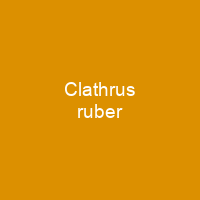Clathrus ruber is a species of fungus in the family Phallaceae. It is commonly known as the latticed stinkhorn, the basket stinkhorn or the red cage. The species was illustrated in the scientific literature during the 16th century, but was not officially described until 1729.
About Clathrus ruber in brief
 Clathrus ruber is a species of fungus in the family Phallaceae. It is commonly known as the latticed stinkhorn, the basket stinkhorn or the red cage. The species was illustrated in the scientific literature during the 16th century, but was not officially described until 1729. The fungus is saprobic, feeding off decaying woody plant material, and is often found alone or in groups in leaf litter on garden soil, grassy places, or on woodchip garden mulches. Although considered primarily a European species, C. ruber has been introduced to other areas, and now has a wide distribution that includes all continents except Antarctica. The fruit body can reach heights of up to 20 cm. The color of the fruit body, which can range from pink to orange to red, results primarily from the carotenoid pigments lycopene and beta-carotene. The gleba has a fetid odor, somewhat like rotting meat, which attracts flies and other insects to help disperse its spores. Although the edibility of the fungus is not known with certainty, its odor would deter most from consuming it. It was not regarded highly in tales in southern European folklore, which suggested that those who handled the mushroom risked contracting various ailments.
Clathrus ruber is a species of fungus in the family Phallaceae. It is commonly known as the latticed stinkhorn, the basket stinkhorn or the red cage. The species was illustrated in the scientific literature during the 16th century, but was not officially described until 1729. The fungus is saprobic, feeding off decaying woody plant material, and is often found alone or in groups in leaf litter on garden soil, grassy places, or on woodchip garden mulches. Although considered primarily a European species, C. ruber has been introduced to other areas, and now has a wide distribution that includes all continents except Antarctica. The fruit body can reach heights of up to 20 cm. The color of the fruit body, which can range from pink to orange to red, results primarily from the carotenoid pigments lycopene and beta-carotene. The gleba has a fetid odor, somewhat like rotting meat, which attracts flies and other insects to help disperse its spores. Although the edibility of the fungus is not known with certainty, its odor would deter most from consuming it. It was not regarded highly in tales in southern European folklore, which suggested that those who handled the mushroom risked contracting various ailments.
It appeared in a woodcut in John Gerard’s 1597 Great Herball, shortly thereafter in Carolus Clusius’ 1601 Fungorum in Pannoniis Observatorum Brevis Historia, and was one of the species featured in Cassiano dal Pozzo’s museo cartaceo that consisted of thousands of illustrations of the natural world. Clathrus cancellatus L. was once referred to by American authors asclathrus., as they used a system of nomenclature based on the former American Code of Botanical Nomenclatures. Since Persoon used the specific epithet ruber, the correct name for the species is ClathRus ruber. The species is part of the group of species known as Laternoid Laternoids. Common features of this group include the vertical arms that are not joined together at the base, and the spongy structure of the receptacle that is not joined to the base. According to a molecular analysis published in 2006, about 40 out of the 40 species used in the study, C ruber is the most closely related to Aseroe rubra, Laternea triscapa, and chrysomycelinus chrysomysens.
You want to know more about Clathrus ruber?
This page is based on the article Clathrus ruber published in Wikipedia (as of Nov. 30, 2020) and was automatically summarized using artificial intelligence.







